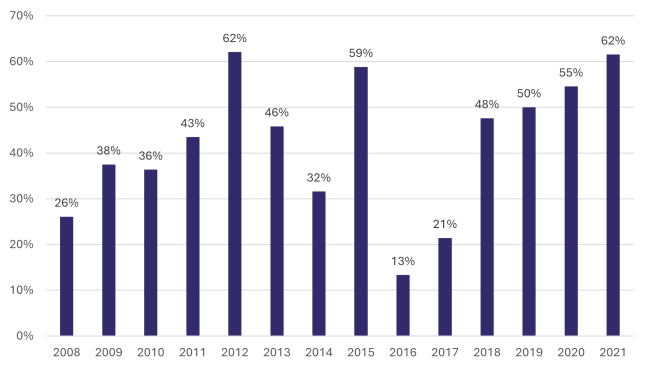End-users' involvement
Insights from the AAL Legacy study
From its beginning, the AAL Programme considered meaningful involvement of end users as essential to ensure that solutions would be relevant and widely adopted. Over fourteen years of project monitoring reveal a clear evolution: engagement moved from episodic consultations with older adults to ongoing collaboration that included not only seniors, but also caregivers, care professionals, public authorities, and funding organisations.
Older adults: Across more than 300 projects, over 60,000 older adults took part. However, participation didn’t follow a straight line. In the early years (2008–2011), projects usually worked with a few dozen seniors for short-term activities like focus groups or pilot tests. Throughout the programme, the typical number of participants per project rose steadily—from around 30 in 2008 to between 70 and 130 in later years—as projects increasingly relied on long-term, real-life trials in homes and care environments. Just as significant was the change in how participants were involved. In 2008, only about a quarter of projects included older people in co-design activities. By the final calls, more than half did, often using structured workshops and rapid prototyping methods. Dips in 2016 and 2017 reflected specific call framings rather than lack of intent.

Caregivers: Including relatives, volunteers, nurses, and therapists, caregivers also became more involved over time, with approximately 14,000 participating throughout the programme. Initially, their contributions were mostly limited to surveys. Later on, particularly after 2014, they were regularly included in testing activities, with around 40 % of projects involving them in hands-on trials. In standout examples, caregivers even helped define features and select evaluation criteria. By 2020, 41 % of projects involved them in formal co-design. This growth was partly driven by projects on dementia, where caregivers often stepped in for users with cognitive limitations, and also by the programme’s emphasis on supporting caregivers rather than simply tracking older individuals.
Public and institutional stakeholders: Such as municipalities, housing bodies, insurers, and healthcare providers, also came to play a more prominent role. While only about a quarter of early projects involved such actors, this rose significantly in later years, especially in calls that required projects to demonstrate integration within broader care systems and long-term sustainability. Municipal and government bodies remained the most common partners, present in roughly a quarter of projects, but involvement by insurers and healthcare providers grew rapidly. Though these stakeholders were often consulted rather than actively designing, their participation helped speed up regulatory approvals and clarify reimbursement pathways—key steps for scaling solutions beyond the pilot phase.
Across all groups, real-life testing was common—used in 95 % of projects involving older adults and 40 % of those involving caregivers. But what truly set later projects apart was the wider adoption of continuous co-creation. Projects that planned multiple design-feedback-redesign cycles before entering the field tended to report better results: less participant dropout, fewer expensive changes late in development, and more convincing assessments. Many of these efforts were supported by living-lab infrastructures created in AAL’s early years, which allowed for months-long deployments in actual homes. These settings provided valuable data on usability, individual well-being and cost-effectiveness. In contrast, projects that relied on one-time surveys or changed course without involving users again often struggled to retain participants or demonstrate real impact.